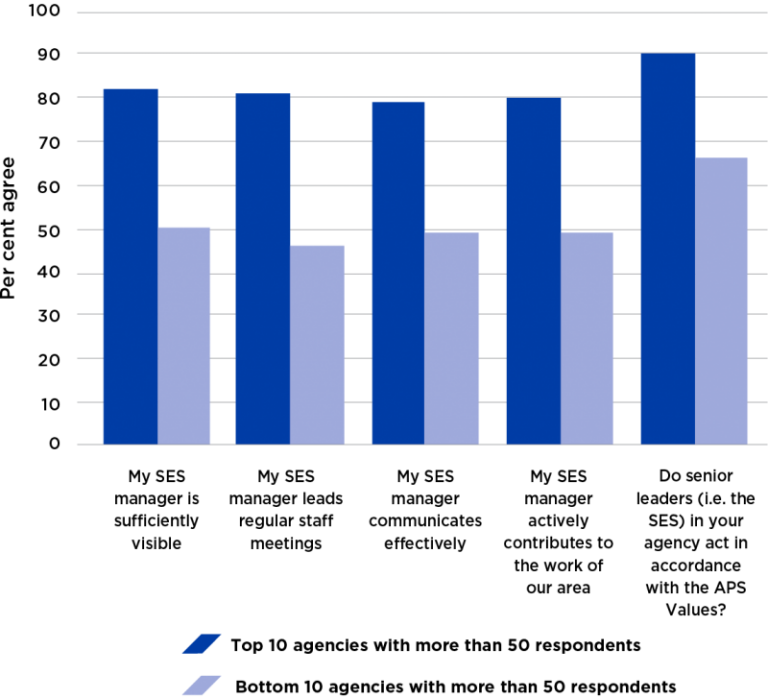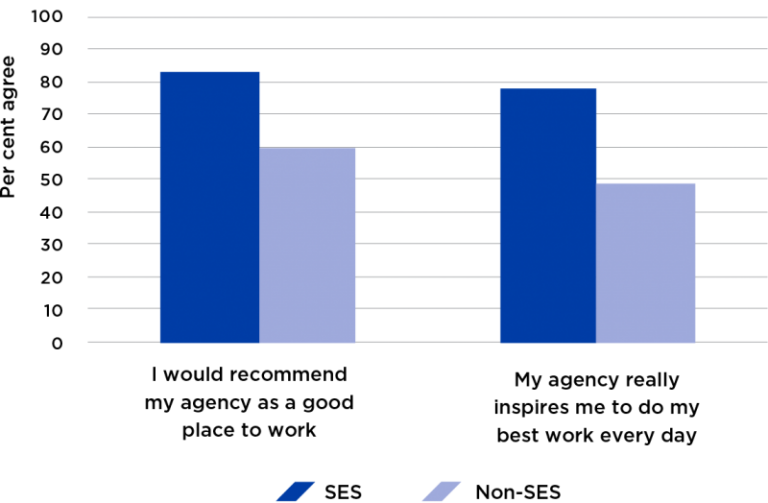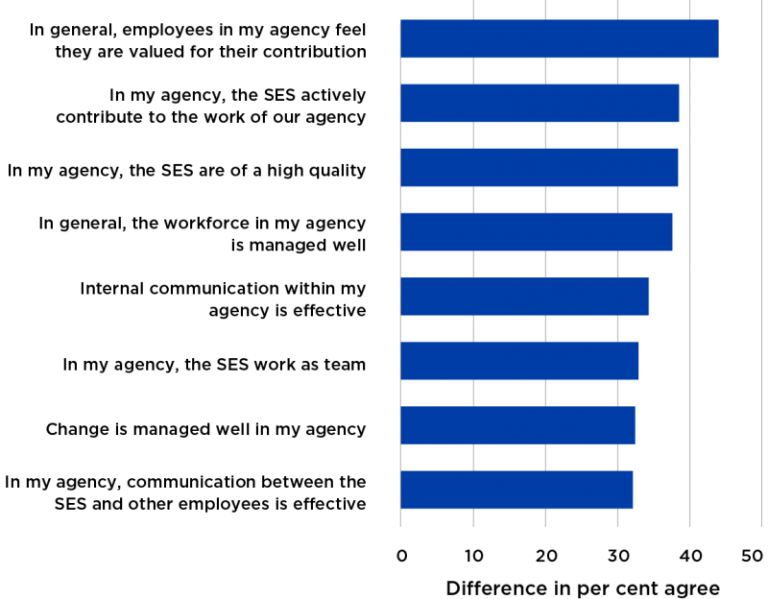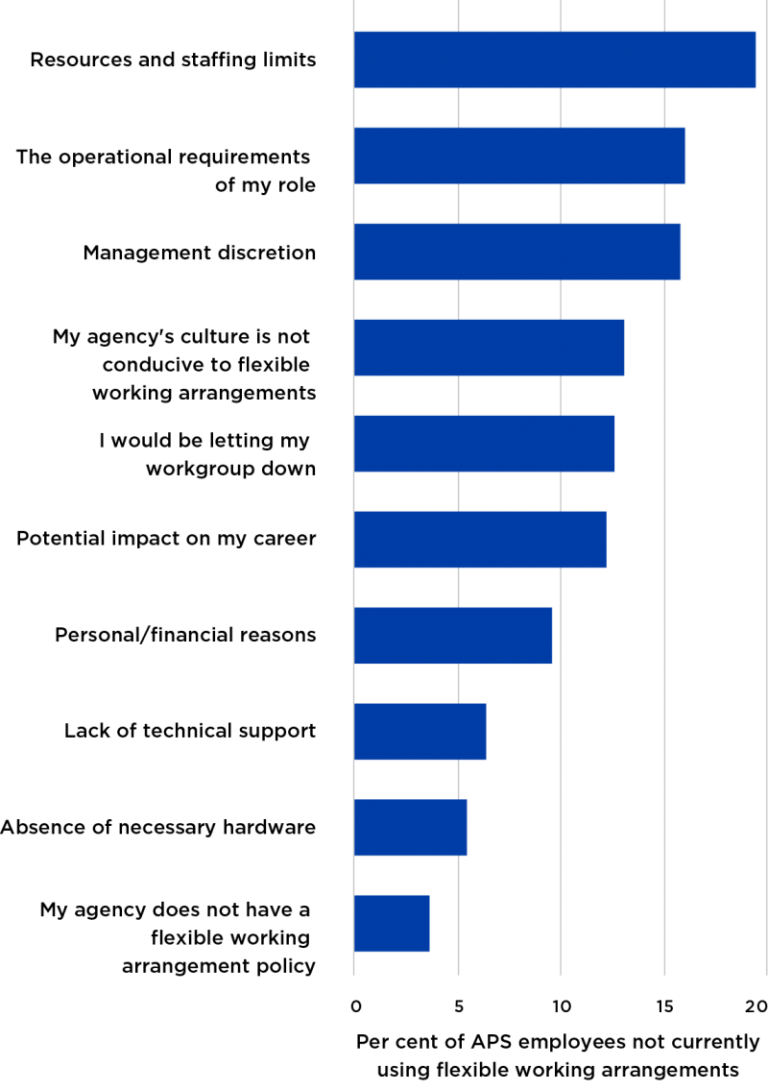Chapter 6: Organisational performance and efficiency
Key points
- Where employees perceived their agency as having high levels of organisational performance, agencies were more likely to have the tools, resources and work processes that facilitate productivity.
- Individuals in higher performing agencies were more likely to be satisfied with work-life balance, have a say in how they do their work, and have a positive attitude towards risk management.
- Employee engagement varies across classification levels in the APS. SES employees have substantially higher levels of engagement compared to EL and APS employees.
- Many employees (82 per cent) agreed that their supervisor actively supports the use of flexible working arrangements by all employees, regardless of gender.
- Employees feeling valued for their contribution was the biggest differentiator between agencies with the highest and lowest wellbeing scores.
Public sector performance
Greater productivity and efficiency underpin the Government’s agenda for a public sector that serves the community and business effectively.
Australian Government expenditure in 2017–18 was $460.3 billion, or 25 per cent of gross domestic product. An efficient and productive APS needs to ensure this expenditure has the best impact on outcomes.55
Assessments about APS performance are usually based on its ability to successfully deliver programs on time and on budget, to process large volumes of transactions, or reduce spending. These measures, while useful, do not necessarily reflect the quality of services provided or the value to the public. Reporting meaningful and comparable public sector performance metrics remains a challenge.
A high-performing public sector is demonstrated by its ability to meet and influence government outcomes. Performance is driven by its leadership, enabled by its systems, processes and governance.
Effective public sector performance is founded on strong supporting legislation. The PGPA Act came into effect on 1 July 2014, bringing improvements to the management of public resources, including working cooperatively with other jurisdictions, planning and reporting.
An independent review of the PGPA Act in 2018 found that it compares favourably to similar frameworks in other countries and provides a good framework for a high-performing public sector.56
The Review made recommendations to drive further change in four key areas:
- leadership—investment to improve performance outcomes
- risk—improvements needed to risk management and risk culture
- outcomes-driven objectives—more work needed to implement the PGPA’s Act objective of cross-government collaboration
- greater transparency—development of clearer performance measures and transparency of outcomes needed.57
The Review acknowledged that performance can be difficult to measure, particularly with quality of policy outputs and effectiveness of government activities and programs. It also found the APS is not alone in its challenges of measuring performance, with international jurisdictions facing similar issues.
While productivity in the private sector can be based on volume or market indicators, the nature of government work, which includes developing policy and delivering public goods, does not easily lend itself towards such measures. Nevertheless, the APS needs to keep moving from focusing on measuring outputs rather than outcomes.
There are strong benefits in tackling these challenges. Appropriate productivity measures are useful in better understanding public sector performance both over time and compared to similar entities. They are also useful in helping demonstrate to the public how well the APS uses its resources.
High-level improvements to public sector productivity are evident. For example, the 150,000 APS workforce is now at its lowest level since 2006, managing a volume of transactions well in excess of 2006 levels. The cost of government administration as a proportion of overall expenditure fell from 8.5 per cent in 2007–08 to 6.9 per cent in 2017–18 and is on track to continue to fall to 5.6 per cent by 2021–22.
Figure 38: Departmental expenditure as a percentage of total Government expenses, 2007–08 to 2021–22

Notes:
- Total government expenses reflects total expenses at the Commonwealth General Government Sector level, and includes activities of all relevant Government-controlled non-market entities. The GGS covers officials employed under the Public Service Act (as APS officials) as well as other arrangements.
- Expenses data from 2007-08 through to 2017–18 is derived from Final Budget Outcome Statements. From 2018–19 onwards expenses data reflects revised budget and forward estimates as at 2018–19 Budget.
- Excludes the Department of Defence and National Disability Insurance Agency.
- This graph is consistent with the Graph 1, the Preface, Agency Resourcing Budget Paper No. 4 2018–19.
The Government Business Analytical Unit, established under the Data Integration Partnership for Australia, is undertaking a pilot to measure productivity of selected public sector functions. The pilot will assess public sector performance against a range of known drivers of productivity, such as risk tolerance, innovation, use of technology, employee engagement and workforce capability.
A range of existing data sources, including output-based sources and employee sentiment indicators, will inform an appropriate basket of productivity measures. The project forms part of the productivity stream under the Roadmap. Benefits from it could include cost savings through more efficient transactional processes, increased employee engagement, greater cross-skilling between agencies leading to more sophisticated policy advice, better alignment of risk and innovation, technology uptake and more flexible use of resources.
Agency performance
Agency performance measures, as reported in their Annual Performance Statements, provide a solid base from which to understand an agency’s key deliverables and whether targets are achieved. Feedback from the APS employee census and APS agency survey provide further insight into workforce perspectives on performance.
In the 2018 APS employee census, employees were asked to reflect on their agency’s success in meeting its goals and objectives using a 10-point scale. On average, employees rated their agency a 6.7, indicating they viewed their agency’s performance as above average.
Figure 39 shows that where employees perceived their agency as having high levels of organisational performance, they also perceived their agencies more likely to have:58
- workgroups with access to the necessary tools and resources
- work processes that facilitate productivity
- workgroup members that complete work to a high standard
- supervisors that ensure their workgroups deliver.
Figure 39: Productivity-related perceptions of APS employees from agencies with high and low perceived organisational performance

Source: 2018 APS employee census
Agencies with higher ratings of organisational performance were also more likely to be viewed positively on multiple metrics. For instance, when comparing higher organisational performance agencies with lower performance agencies, immediate supervisors were seen as more:
- likely to be encouraging, consultative and welcoming of new ideas and suggestions
- committed to developing employee capability
- committed to performance management.
There is also a contrast between how SES managers are viewed in high and low-performing agencies. Respondents from agencies with perceived high levels of performance were more likely to indicate that their SES managers were visible, led regular employee meetings, communicated effectively, contributed to the work of their agency, and acted in accordance with the APS Values (Figure 40).
Figure 40: Perceptions of SES managers held by APS employees from agencies with high and low-perceived organisational performance

Source: 2018 APS employee census
APS employees of agencies with perceived higher levels of performance were more likely to believe their agency was a better manager of change, had more effective internal communication and was more likely to promote an inclusive workplace culture. These agencies were also viewed as being better managers of their workforces and having sufficient opportunities for career progression.
Where agencies were rated as higher performing, individuals were more likely to be satisfied with their work-life balance, feel they had choice in how they did their work and hold more positive attitudes towards risk management.
When viewed holistically, respondents from higher performing agencies reported higher levels of employee engagement and more positive attitudes towards innovation and wellbeing.
Cutting red tape
Unnecessary regulatory burden, or red tape, is a known inhibitor of action and decision making. Cutting red tape is important for improving efficiency both in the public sector and for the community. It has been an objective of successive governments since the 1970s.59
The last review of government red tape, the 2015 Belcher Red Tape Review, encouraged removal of internal red tape to enable agility and responsiveness, and to develop a culture of risk management rather than regulation.60 Four whole-of-government themes emerged from the review:
- over regulation
- inefficient regulation
- unclear and inaccessible regulations and guidance
- culture of risk aversion.61
In the 2018 APS employee census, employees were asked to rate the level of action within their agency to reduce red tape on a scale of 1 to 10 (with 1 being no action and 10 signifying the highest level of action). The level varied across agencies, with an average level of 5. This is consistent with the previous year.
This result suggests that cutting red tape may go unnoticed, may not be well-promoted within agencies, or may not be pursued by the agency. Also, employees may not see red tape removal beyond their immediate workgroup.
Collaborating for better outcomes
To deliver most value to the public, the APS must collaborate and be well connected across agencies, jurisdictions, businesses and the community.
Many examples highlight the APS’s ability to work effectively with multiple tiers of government, community organisations, businesses, and educational institutions to deliver quality community outcomes.
Responses to the 2018 APS agency survey demonstrated collaborative initiatives, such as the:
- Department of Agriculture and Water Resources collaborating with the University of Melbourne’s Centre of Excellence for Biosecurity Risk Analysis, relevant state and territory agencies and New Zealand authorities to research ways to combat growing biosecurity threats
- Great Barrier Reef Marine Park Authority collaborating with the Australian Institute of Marine Science, the CSIRO, Reef and Forest Research Centre, and several universities (James Cook, Queensland and Sydney) to enhance the effectiveness of Crown of Thorns Starfish surveillance and control
- National Library of Australia working with state and territory libraries to maintain the National Electronic Deposit service for accessing published electronic material across Australia.
Department of Infrastructure, Regional Development and Cities—City Deals
The Government’s negotiation of City Deals is an example of active engagement by the Australian Government with state, territory and local governments, as well as the community. City Deals is a tailored partnership aligning the planning, investment and governance across three levels of government to accelerate growth and job creation, stimulate urban renewal and drive economic reforms. City Deals allow customised approaches to addressing particular needs of Australian cities.
The Western Sydney City Deal, signed in March 2018, is an agreement between the Australian and New South Wales (NSW) governments and eight councils in Sydney’s outer west. With the 2016 Census reporting that around 40 per cent of workers living in the City Deal region travelled outside of the area for work, and the population of Western Sydney set to grow by an extra one million people over the next 20 years, including more than 450,000 in the City Deal region, a new approach was needed. The City Deal sets up agreed conditions for the planning, reforming and investing needed to transform Western Sydney and provide the public with the transport, housing, employment and educational opportunities needed to accommodate growth.
This City Deal includes enduring governance arrangements between the three levels of government around better aligning planning, investment and policy decision making for Western Sydney. These governance arrangements are supported by a tri-government delivery office to co-ordinate delivery of City Deal commitments. Australian Government employees work in the Parramatta-based City Deal office.
The needs of the community are at the heart of the Western Sydney City Deal. The Australian and NSW governments have worked closely with local councils to identify local community needs. Through the joint governance arrangements, councils will continue to apply community views to shape the City Deal.
The Western Sydney City Deal will achieve significant outcomes for Western Sydney residents.
The APS is capable of working well within an essentially hierarchical system. The cross-agency taskforce model is regularly deployed to address issues requiring multi-disciplinary skills. While there is evidence that demonstrates effective collaboration, there are also examples where poorer policy outcomes have resulted from a disconnect between front-line service delivery and relevant policy areas. These lessons emphasise the need to work collaboratively for successful delivery of policy and continuous improvement of services.
Efforts to improve public outcomes by mobilising capability are described in Chapter 8, Mobilising capability.
To ensure confidence, we need to pay attention to both policy development and delivery. Each of us needs to consider how the ultimate recipient, the citizen, will experience, or be impacted, by a policy.
Kathryn Campbell, CSC, Secretary, Department of Social Services62
Workplace relations
Workplace relations arrangements underpin and inform many aspects of HR management. These arrangements support consultation and cooperation across organisations, with the view to continuously improve organisational performance. This is particularly important when managing complex organisational change.
Trust is an important feature in a healthy workplace relations environment. Arrangements for workplace relations support and build employer-employee relationships. Strong, positive leadership
and effective communications are essential. SES and line managers need to work together to foster such an environment. The 2018 APS employee census results on leadership performance are outlined at Chapter 9, Leadership and stewardship.
Each APS agency is responsible for its own workplace relations arrangements within a legislative and policy framework. These arrangements can support or stymie workforce performance and productivity. Over recent years, APS workplace relations have focused on the effect of enterprise agreement content on agency performance.
A key government objective is modernising public sector workplaces so they can adapt quickly to changing operational needs. Large shifts in the economy and changing priorities of agencies will continue over the coming decade.
Paragraph 2(a) of the Government’s Workplace Bargaining Policy 2018 states that ‘enterprise agreements and other workplace arrangements are not to contain restrictive work practices, unduly limit flexibility, or otherwise impede workplace reform’.
The removal of administrative detail and procedures from enterprise agreements enables agencies and employees to:
- respond more flexibly to changing circumstances and priorities
- take advantage of new workplace innovations more quickly
- pursue different ways of working through technological change.
In addition to flexible workplace arrangements, agencies pursue measures to improve workplace productivity. Examples include:
- business process improvements
- capability development
- technological improvements
- reforms to HR policies and delegations
- staffing or establishment reviews
- performance management streamlining
- flexible workforce structures and resourcing.
Increasingly the APSC is seeing a shift in agency thinking from finding productivity gains within enterprise agreements to seeking these gains more broadly within their operations. This is consistent with the Government’s Workplace Bargaining Policy 2018, which requires agencies to identify productivity improvements to support their proposed remuneration increases.
In 2017–18, employees in 18 APS agencies voted up new enterprise agreements. Generally strong employee support for recent enterprise agreement ballots and a low level of protected industrial action suggests that employees are largely satisfied with their employment terms and conditions. This is broadly consistent with the 2018 APS employee census results, where more than three-quarters of respondents reported satisfaction with their non-monetary employment conditions.
Thirty-six APS enterprise agreements reach their nominal expiry dates in 2018–19. In some instances, agencies and employees are considering providing wage increases through determinations made under the Public Service Act while leaving nominally expired enterprise agreements in place.
In response to agency demand and the need for greater strategic focus on workplace relations, the APSC is working with agencies to enhance the capability of their workplace relations specialists and raise awareness of good workplace relations practice. The Workplace Relations Capability Program includes:
- resources such as a bargaining guide
- peer-to-peer learning through small group sessions and panel events
- problem solving through small group sessions.
Engagement
Research over many decades has shown that high levels of employee engagement are associated with positive benefits. These include better organisational performance, productivity and retention. Engagement is more than job satisfaction or commitment to an organisation. It is the extent to which employees are motivated, inspired and enabled to improve organisational outcomes. It is a two-way relationship between an employee and their organisation.
The employee engagement index included in the APS employee census measures the emotional commitment that employees have to working for their organisation.
In this model, an engaged employee will ‘say’, ‘stay’ and ‘strive’:
- Say—the employee is a positive advocate of the organisation.
- Stay—the employee is committed to the organisation and wants to stay.
- Strive—the employee is willing to put in discretionary effort to excel in their job and help their organisation succeed.
Results of questions against each element produce an overall engagement index score. This score for the APS in 2018 was 70.
Across APS agencies, levels of employee engagement vary. Results from the 2018 APS employee census show some key factors differentiating between agencies with the highest and lowest engagement scores.
Figure 41 shows that agencies with a higher engagement index are perceived as more than 30 percentage points better in their SES actively contributing to the work of the agency, seen as high quality, regularly leading employee meetings and supporting flexible work. These agencies are also perceived by their employees to be better in providing opportunities for mobility, to care about employee health and wellbeing, and to provide opportunities for autonomy and choice in how to perform work.
Figure 41: Percentage point differences between the top 10 and bottom 10 agencies for employee engagement

Source: 2018 APS employee census
What drives employee engagement varies from agency to agency with some differences due to size and function. In examining drivers for employee engagement, some of the highest factors influencing this in the APS include:
- employees believing that one of their responsibilities is to continually look for new ways to improve the way they work
- employees having a clear understanding of their development needs
- employee satisfaction with recognition for doing a good job
- employees having a clear understanding of how their workgroup’s role contributes to their agency’s strategic direction
- agency managing change well
- agency actively encouraging ethical behaviour by all employees
Employee engagement also varies across classification levels in the APS. Figure 42 shows that SES employees have substantially higher levels of engagement compared to EL and APS employees.
Figure 42: Employee engagement scores by classification

Source: 2018 APS employee census
A number of employee engagement items indicate large differences between SES and non-SES respondents. In particular, a greater proportion of SES respondents would recommend their agency as a good place to work and feel their agency inspires them to do their best every day (Figure 43).
Figure 43: APS employee perceptions of their agency, SES and non-SES employees

Source: 2018 APS employee census
Wellbeing
Employee wellbeing is important for maintaining high performance and high levels of employee engagement. The APS employee census measures the practical and cultural elements allowing for a sustainable and healthy working environment.
The wellbeing index included in the APS employee census provides a measure of wellbeing for employees within an organisation. The overall index for the APS in 2018 was 66, a one percentage point increase from 2017.
Figure 44 shows that agencies with a higher wellbeing index are perceived as being more than 30 percentage points better in:
- SES actively contributing to work, seen as high-quality, working as a team member and communicating effectively with others
- managing the workforce and change well
- communicating effectively.
Employee census results suggest that employees feeling valued for their contribution is the biggest differentiator between agencies with the highest and lowest wellbeing scores.
Figure 44: Percentage point differences between the top 10 and bottom 10 agencies for wellbeing

Source: 2018 APS employee census
Most 2018 APS employee census respondents (81 per cent) believed their immediate supervisor cared about their health and wellbeing and were comfortable in approaching their immediate supervisor about personal circumstances that may impact on work.
Flexible work
APS agencies need workforce flexibility to adapt quickly in a rapidly changing environment. This can be achieved while still ensuring employee work-life balance. Flexible work encompasses practices supporting when, where and how work can be conducted.
The APS has a reasonably flexible work culture. Approximately half of respondents in the 2018 APS employee census said they access flexible working arrangements. The other half said they did not need to do so.
Out of all respondents:
- 82 per cent agreed their supervisor actively supports the use of flexible working arrangements by all employees, regardless of gender
- 60 per cent agreed their SES manager actively supports the use of flexible working arrangements by all employees, regardless of gender
- 77 per cent said they were satisfied with their non-monetary employment conditions, including access to flexible working arrangements
- 74 per cent said they were satisfied with work-life balance in their job.
It is not always possible to access flexible working arrangements in specific jobs. Some operational environments require more structured approaches to work, for example with shift work. The top three barriers to flexible work reported were: resourcing and staffing limitations; operational requirements of the role; and managerial decision making (Figure 45).
Figure 45: Barriers cited as reasons for not using flexible working arrangements

Source: 2018 APS employee census
55 The Treasury (2018), Final Budget Outcome 2017–18, Canberra.
56 https://www.finance.gov.au (accessed 16 October 2018).
57 https://www.apsreview.gov.au/news/tale-of-2-reviews (accessed 16 October 2018).
58 Analysis in this section presents results when there are more than 50 respondents to the question. This is to facilitate agency comparisons and prevent results from being skewed towards small agencies who typically exhibit more positive views.
59 Australian National Audit Office (2016), Implementing the Deregulation Agenda: Cutting Red Tape, ANAO Report, no. 29, 2015–16, Canberra.
60 Belcher, B (2015) ‘The Independent Review of Whole-of-Government Internal Regulation’, Canberra.
61 Department of Finance (2015), Independent Review of Whole-of-Government Internal Regulation (Belcher Red Tape Review), Report to Secretaries Committee on Transformation.
62 IPAA Secretary Series, 26 September 2018.



